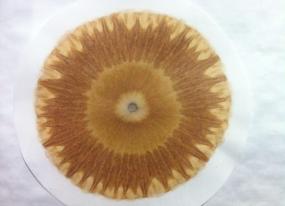Impregnation of a soil croma performed in a Cali artisanal laboratory, April 2, 2018. The result shows a strong presence of organic material and minerals, however, not available due to soil compaction. In other words, the nutrients that make up a soil are visually present but for lack of balance and energy (aeration, access to water), they remain in disharmonies: the different zones are clearly distinguishable. For more information, see chapter II of Jairo Restrepo's book.
Chromatography is a qualitative method whose principle goal is to decompose the soil components (microbiology, minerals, organic material). The result is visual and allows the interpretation of the interactions between these components, according to the specific context in which the soil is submitted and according to a certain amount of characterisations established over time by the biochemists interested in it.
Chromotography has existed since 1900 and is a technique of qualitative analysis of soil that is little known and in the academic and professional field is not respected. It was initially developed by the Russian botanist Mikhail Tswett to separate the different pigments of plants, in this case chlorophyll. The technique continued to developed in Germany, among others by the philosopher Rudolf Steiner, also founder of biodynamics.
The philosopher used it to analyze the development of pathogens such as syphilis and tuberculosis, experiments which gradually led him to investigate the sap of plants and pulps in order to determine the quality of the elements (by physical and chemical characterization), while considering the external and internal systemic elements of production (among others the influence of the lunar cycle in the presence of salts within the elements). Others will be interested over the years, for various purposes, if not in the end, the German biochemist Pfeiffer, who perceives in the technique, a real potential for the in-depth analysis of soil microbiology. In Latin America, the first book on the theme appears in 2015 entitled Cromatografía, imágenes de vida y destrucción del suelo. A book published by Jairo Restrepo Rivera, international consultant and agronomist at the Brazilian Federal University of Pelotas. It is necessary to mention the importance of Jairo Restrepo Rivera's work in advancing the democratization of peasant knowledge is a tool to fight agribusiness giants. Jairo is indeed a unique reference for Regenerative Agriculture in Latin America, to dare to rethink power relations – always in this logic of food the development of techniques, tools, knowledge and organizational processes that go beyond the path from Green Revolution to Free Trade.
In the same way that we have recently seen here in Quebec alternative production movements such as permaculture, biointensif, nourishing villages, food solidarity, concepts resulting from the influence of several schools of thought including the agroecology of Pierre Rabhi (France) or, more recently, Jean-Martin Fortier's small-scale vegetable production, Jairo Restrepo's contribution to organic farming, same as the other avant-garde activists from other countries, is in itself a revolution in the way of thinking the field methodology in a systemic way. In this case, the chromatography allows a control in real time, adapted to the local realities, precise and completely independent of the industrial / scientific circuits and especially in regard to the biological certifications that allow a socalled "access" to the market. A title that, by definition, paradoxically makes these products certified, unattainable. Indeed, by looking at its own definition, the term access to something implies in itself the fact of obtaining a state deemed superior to the situation or the rank occupied until then, which certification entails. Overgrading a biological product that comes from the natural state of the soil and therefore belongs to its original nature, signals that we still have too little understanding of the microbiology of the soil where we grow, in this concern in quantity rather than quality. Reading the soil differently can help us understand the quality of its living and dynamic interactions. Thus, the methodology to follow is described in it the same name: Chroma = Colors, Graphos = Writing.
Finally, the technique helps to dignify the work and has helped given rise to artisanal laboratories in Colombia. This is the case, among others, for Tierra Libre in Bogotá or for Surcomún in Cali, where as part of PASC accompaniment, the development of such a laboratory is an opportunity to strengthen knowledge, with the aim of combining and integrating an in-depth methodology into organic farming projects.
See : https://morralcampesino.files.wordpress.com/2016/03/cromatografia-restrepo-pinheiro.pdf
